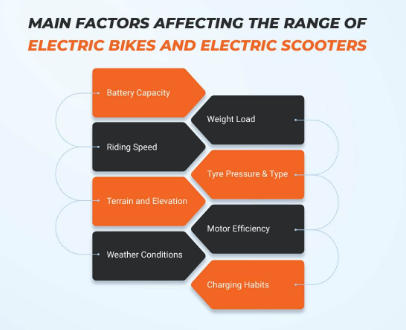
- 29 Apr, 2025

The range of an e-bike depends on a combination of factors, primarily the battery capacity, motor efficiency, and riding conditions. Understanding these factors can help riders estimate how far they can travel on a single charge and choose an e-bike that meets their specific needs.
Key Factors Affecting E-bike Range:
Battery Capacity:
Measured in watt-hours (Wh), higher capacity batteries provide longer ranges. Typical capacities range from 250 Wh to 1,000 Wh or more.
Motor Efficiency:
The efficiency of the motor and the power it delivers (measured in watts) influence how much energy is consumed during a ride.
Assist Level:
E-bikes offer different levels of pedal assist or throttle. Higher assist levels use more battery power and reduce range.
Rider Weight:
Heavier riders require more power to move, reducing the overall range.
Terrain:
Riding on flat terrain consumes less power than riding uphill. Off-road conditions can also affect range.
Speed:
Higher speeds increase air resistance and power consumption, reducing the range.
Riding Style:
Frequent starts and stops, aggressive acceleration, and riding at high assist levels consume more power.
Weather Conditions:
Wind resistance and temperature extremes (hot or cold) can affect battery performance and range.
Tire Type and Pressure:
Properly inflated tires and tires designed for the specific terrain (road, mountain, etc.) can optimize range.
Typical Ranges:
Entry-level e-bikes (250-400 Wh batteries): 20-35 miles (32-56 km) per charge.
Mid-range e-bikes (400-700 Wh batteries): 35-60 miles (56-96 km) per charge.
High-capacity e-bikes (700-1,000+ Wh batteries): 60-100+ miles (96-160+ km) per charge.
Examples of Specific E-bike Ranges:
Commuter E-bikes: Often range between 30-60 miles (48-96 km) on a single charge, depending on battery size and assist level.
Mountain E-bikes: Typically have ranges from 20-50 miles (32-80 km), as off-road riding and hilly terrain consume more power.
Long-range E-bikes: Designed for extended travel, some models can reach up to 100 miles (160 km) or more with high-capacity batteries and efficient motor systems.
Comments (0)